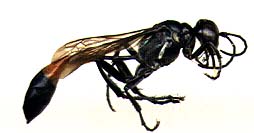Ammophila urnaria Dahlbom 1843. Probably the commonest species of Ammophila in eastern North America, A. urnaria occurs from the eastern side of the Rocky Mountains to the Atlantic coast, from southern Canada to Florida (Menke 1965, Krombein 1979). Extremely widespread in Michigan, A. urnaria is the most often collected species of the genus.
BIOLOGY: Nests are excavated in Þrm, often pebbly soil in a variety of situations such as waste areas, paths, gravel pits, and unpaved roads. Prey are located in low herbaceous vegetation, shrubs, and small trees that surround the nesting site. Small geometrid and noctuid larvae are captured, which the wasps often carry in şight to the nest. One to six prey are mass-provisioned in the cell at the end of the oblique or vertical burrow (Evans 1959, Powell 1964, pers. obs.)
FLOWER RECORDS: Achillea millefolium, Chrysanthemum leucanthemum, Clematis virginiana, Daucus carota, Erigeron philadelphia, Erigeron spp., Melilotus alba, Rubus sp., Solidago juncea.
COLLECTION DATES: 600+ specimens, 30 May to 1 October, with most dates in late July to mid-August. Collection records suggest that A. urnaria, like A. harti, may be bivoltine.

![]() BACK to Main Page
BACK to Main Page